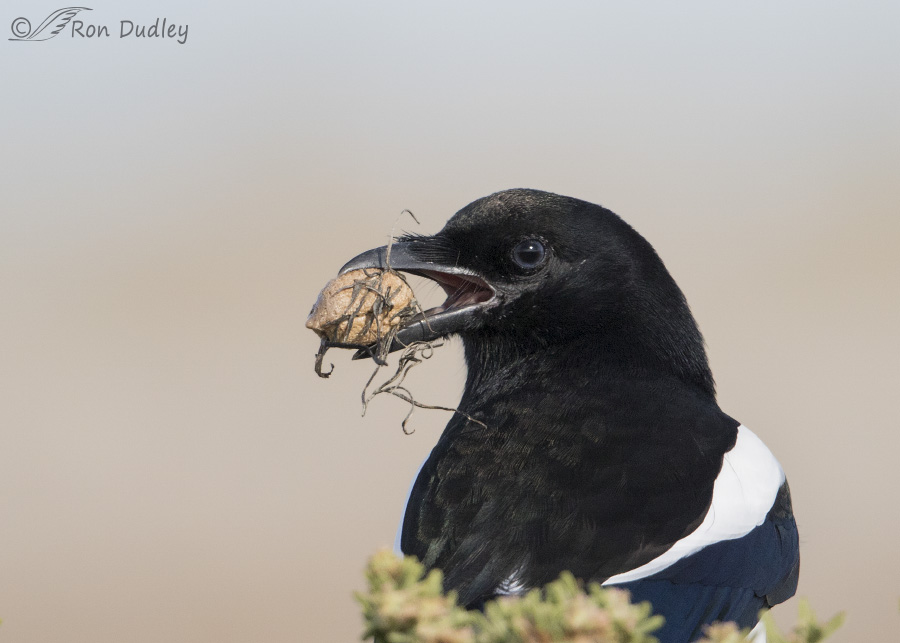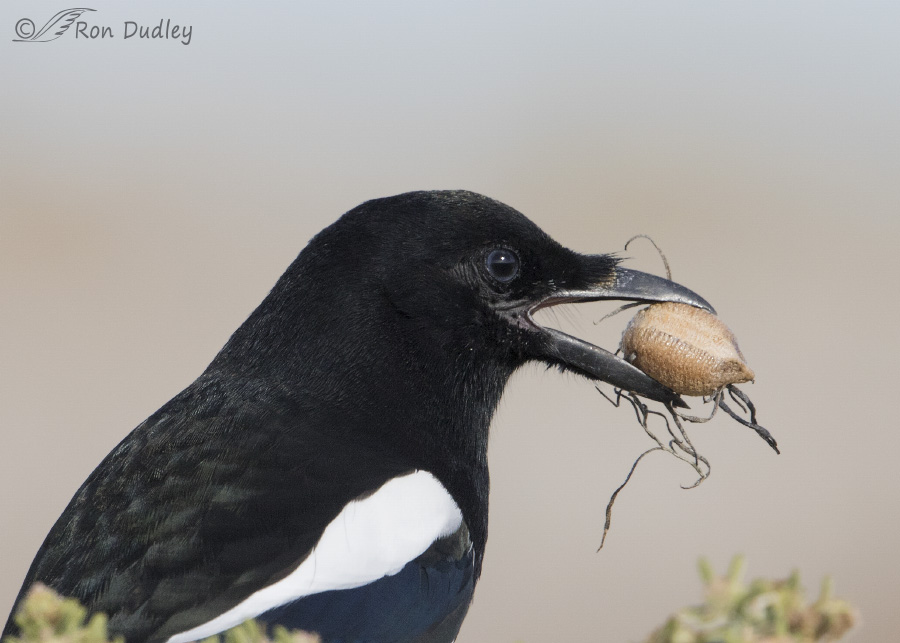Black-billed Magpies prefer to eat arthropods, seeds and carrion but being omnivorous they aren’t fussy and will consume a wide variety of food items. Yesterday morning on Antelope Island I photographed one with a new (for me) twist in its diet.

1/2500, f/5.6, ISO 800, Canon 7D Mark II, Canon EF500mm f/4L IS II USM +1.4 tc, not baited, set up or called in
After a slow morning on the island I approached this magpie next to the road as I was preparing to head for home. It didn’t fly off as I expected it to when I drove by and I noticed that it had something in its beak so I stopped for a look through my lens. At first I thought it was a peanut but further inspection revealed it to be a praying mantis egg case (I believe) along with some debris.

1/1600, f/7.1, ISO 800, Canon 7D Mark II, Canon EF500mm f/4L IS II USM +1.4 tc, not baited, set up or called in
Here’s a better look at a different angle. Over the years I’ve seen magpies with an almost endless list of food items but for me this was something new and I thought it was interesting enough to post a couple of photos, even though they’re huge crops.
And speaking of magpie diets (and complex behaviors) here’s a little natural history snippet from Birds of North America Online that I find hugely interesting. It’s a bit of a read but I recommend wading through it to the end. It’s definitely worth it.
- “In Alberta in early spring, moose have average of 32,000 winter ticks (Dermacentor albipictus) on them. Magpies frequently land on moose to feed on winter ticks (such foraging seldom elicits any noticeable response from moose). Magpies cache ticks prodigiously, preferably on bare ground rather than in nearby snow. Most of these ticks are alive and unharmed when cached (W. Samuel pers. comm.). If not recovered later, ticks may survive to egg-laying stage, potentially increasing future number of ticks on which magpies might feed. Many moose die each spring from blood loss and other tick-related problems, and magpies scavenge the carcasses. Ticks and moose, as well as other ungulates, are probably critical sources of energy for magpies in early egg-laying stage of reproduction, and their caching behavior may well result in increased supplies of ticks and carrion.”
In other words, magpies may deliberately “farm” both ticks and moose as future food sources. The more ticks the more moose carcasses and they eat both.
I find that immensely fascinating!
Ron


I just had an encounter with a very large Carolina Mantid here in New Mexico. I videoed it and uploaded it. LOL I did the same with a male tarantula on the mating move this past weekend. Fascinating creatures in my new home!
Definitely a mantis egg case… Fascinating information about their diets! I photographed some Acorn Woodpeckers the other day and found one of them not only stashing away acorns in their granary tree, but some Pipevine Swallowtail butterfly chrysalises as well… Nature is remarkable.
“Nature is remarkable.”
Yes, it is, Mary. And usually the birds don’t read the field guides to find out what they’re supposed to be eating…:)
How intriguing. I wonder whether our magpies do something similar. They do domesticate some humans very skilfully. So many animals are practical, pragmatic and forward thinking…
“They do domesticate some humans very skillfully”
That made me smile, Ec.
I enjoy magpies and used to feed them mice from my traps and the skeletons of carp I had filleted off the meat. I have a picture of a magpie on a deer in winter snow. I bet they probably eat the ticks off of deer as well. Neat pictures. Learning about bird behavior is always interesting.
Marilyn, I like magpies enough that I have one of my photos of one hanging over my fireplace.
Anthropomorphism aside, time is a great developer of Symbiotic relationships in all their ramifications. Very interesting read and excellent shots.
Many thanks for sharing.
Thank you, Dick.
The BNA info is definitely very interesting. To go back to a previous discussion, so much for bird brains! The Magpie’s food definitely looks like a mantis egg case. Birds are fascinating creatures, and I enjoy all the learning I get from reading your blog posts.
Thanks, Susan. Nice of you to say so…
Fascinating, Ron! It had never occurred to me that large mammals were a reliable source of insects, even through the winter. O
But of course! Hummm, also that the trophy hunter who goes after the big moose deprives birds of their winter cafeteria. We know not what we do, once again.
The web of life can be pretty complex, can’t it, Mikal? Thank you.
I now live in the Cotswolds, in England and Magpies here are beautiful birds. However, they are not appreciated by the many farmers and wealthy estate owners here as they feed on song bird eggs and chicks. They are often trapped and killed and as a result are very wary of people. I understand why they are not wanted as to the credit of many residents there is a strong effort ti increase song bird populations but it is very difficult to see a beautiful Magpie being used as a lure for other magpies by being placed in a small live trap.
This was a very interesting post and great photos.
I just don’t understand the attitude of those folks, Wendy. Many, many other bird species also feed on songbirds and their eggs and chicks – it’s just natural behavior for them to do so. The extension of their argument would be to kill so many other species…
Thanks for relating your story.
Lovely shots, Ron. Magpies are one of my favorite birds, both in looks and behaviors. They’re so very clever, and striking to look at. These may be ‘huge crops’ but for someone who loves macro shots in my own photography, I really enjoyed these. Up close and personal is always fun!
I often put out peanuts in the winter for the Magpies around my home. The caching behavior makes me laugh. I think I ended up with at least half the nuts in my rain gutters.
Their flock dynamic was fun to watch too. I had 3 that nearly always came together. The leader would land near the pile of nuts, and sort through them. (in my head she was a she,) and she would make two piles of the nuts. She’d thump them, peck them, and shake them. then she would grab one from her approved pile and fly off. the other two would cautiously approach, and take nuts ONLY from her discard pile. When she came back they would again retreat and wait for her to take what she wanted. Fun stuff!
Thanks for sharing all your wonderful work with us!
You describe some very interesting behavior, Philina. I’d love to see that. Magpie behavior is just so interesting!
Very interesting series, Ron!! For one – I didn’t know that a praying mantis egg case looked like that & that it’s so big!! And I loved the info on the Magpies diet. The poor moose being covered with 32,000 ticks – ugh!! What clever birds the Magpies are. I just enjoy the education that comes with your photos – 2 for the price of one!!
That many ticks would be an almost endless food supply for a variety of species that pick ticks off of ungulates, Jo Ann. Ahhh, the complexities of nature…
I would NEVER underestimate any corvid!!! Especially Crows, Magpies and Ravens!!! You can add Blue Jays to that group, too….
Nor would I, Patty…
Great shots, very interesting!
Charlotte
Thank you, Charlotte.
As part of the corvid family, you just never know what magpies might do! I thoroughly enjoy corvids and miss seeing magpies regularly now that I’m in NY. Gotta get back west!
Agreed, Laura – the entire corvid family is splendidly interesting.
It is fascinating tho I have a VERY mixed relationship with Magpies and their “varied” diet that includes dog food and chicken food here if not carefully dispensed/guarded. They will go in our coop through the chicken door generally one in while one watches outside. 🙂 They are useful however to notify of “critters” in the brush and watched them run a coon out of a tree last spring. Nice photo’s. 🙂
Lots of folks have mixed feelings about magpies for a variety of reasons, Judy. They are what they are…
Thank you.